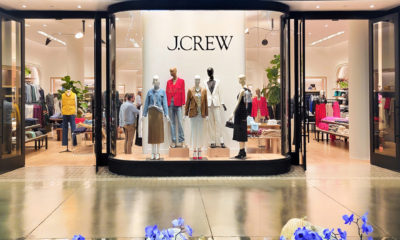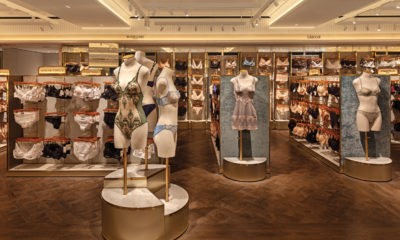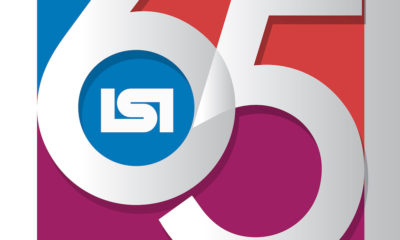It’s been a while since lighting a store meant simply installing enough bulbs in the ceiling so customers could find their way around and read the price tags. And even with all the conversation lately about the energy efficiency and technology of retail lighting, its main purpose is as a dramatic enhancement to drive sightlines, create mood and shadows, enliven merchandise presentations, uplight, downlight, wash walls and bathe corners.
“Lighting helps establish traffic patterns, mood and environment,” says Abigail Rosen Holmes of Los Angeles-based lighting consultancy Nyx Design. “And more than that, it helps create and reinforce brand identity.”
Holmes cites the freestanding Apple stores – like the one on Fifth Avenue in New York – that are brightly and evenly lit, contributing to the brand’s modern identity and to the store’s role as an entertainment destination. “It encourages people to spend time in the store even when they’re not purchasing anything,” she says.
“Light is invisible radiant energy,” adds lighting designer Stefan Graf of Illuminart (Ypsilanti, Mich.). “Different lights give stores different feelings and, ultimately, impact the brand image.”
Evolving technology has widened the options available to do all that, and some lamp types accomplish certain objectives better than others. Traditional incandescent bulbs are warm and best approximate daylight, so they tend to have the best color rendering – which is important if you’re selling apparel and want to make sure the customer can distinguish the black sweater from the navy blue. And because of the pure light they emit, they’re better sources for dressing rooms and makeup areas. But they’re also hugely inefficient and have short lamp lives.
Fluorescent tubes produce a soft, ambient glow and were the lamp of choice for most big-box retailers for years. But they emit a general spread of light that’s not particularly exciting. Designers don’t like the look of the tubes in the ceilings, especially coupled with the bulky ballasts required to ignite the arc discharge. Fluorescent tubes lose whiteness and flicker as they get old. And they’re plagued with issues of disposability, due to the toxic mercury in the tubes.
Compact fluorescent lamps (CFLs) are more decorative and more efficient than linear fluorescent tubes but have roughly half the lamp life. Halogen PAR lamps have long light throws (making them useful in spaces with high ceilings) and good color rendering, but they burn hot and burn out. Metal halides are effective where accent lighting is needed, and they’re low wattage, making them useful in places where the local electricity usage codes restrict watts-per-square-foot. But they, too, have relatively short lamp lives and frequent replacement just adds to costs.
The current darling of the lighting industry is the LED lamp, which has evolved from the color-changing display novelty of a decade ago to an increasingly reliable source of white light. A Star Market store in Newton, Mass., recently lit its entire 53,000-square-foot space with LEDs.
“Right now, LEDs produce about 50 lumens per watt,” says lighting designer Paul Gregory, principal at Focus Lighting (New York), “slightly less than fluorescents. But they’ll soon hit 120 lumens per watt. And then they’ll be a retail lighting designer’s best light source.”
As it is, says Gregory, LEDs produce a narrower beam of light than fluorescents do, making them more efficient and adding sparkle to the merchandise. “If you want to light diamonds,” he says, “an LED light in a display case does the job better. It doesn’t emit light in all directions, like fluorescent light does. It doesn’t produce much heat. And it’s a tighter, more compact light with better color rendering than a metal halide.”
Gregory suggests lighting one store – or a section of the store – with LEDs and comparing power consumption and sales in that store to another store lit with other lamp types. “I think you’ll see dramatic results,” he says.
But some designers caution that while LEDs are energy efficient and emit little heat, they don’t accomplish all objectives. For one thing, LEDs are still more expensive than other lamp types. But “expensive” is not necessarily an absolute term when considering store lighting. Illuminart’s Graf warns that costs can be viewed in two ways: the size of the initial check you write for equipment and installation, and the long-term costs (or savings) of the system you install.
“Life-cycle analyses suggest you can recoup higher upfront costs in two-and-a-half to three years by using the right lighting systems,” he says. “I’ve seen instances where we could cut maintenance costs by as much as 80 percent and energy costs by 30 percent and reduce the number of light fixtures in the store by 50 percent, even with a 50-60 percent increase in the cost of equipment.” For example, Graf says, by replacing 60-watt halogens with 40-watt metal halides, you might use 30-40 percent fewer fixtures and get an energy payback in two-and-a-half years.
And, lighting designers emphasize, there’s yet another cost consideration: the impact of the lighting system on sales. “Your return on investment will not be measured simply in terms of cost and energy efficiency,” says Holmes of Nyx Design. “It’s also a matter of the impact on sales and on the long-term life and extension of the brand identity and how the customer relates to it.”

 Headlines1 week ago
Headlines1 week ago
 Headlines2 weeks ago
Headlines2 weeks ago
 Headlines7 days ago
Headlines7 days ago
 Headlines1 week ago
Headlines1 week ago
 Designer Dozen2 weeks ago
Designer Dozen2 weeks ago
 Headlines2 weeks ago
Headlines2 weeks ago
 Headlines2 weeks ago
Headlines2 weeks ago












